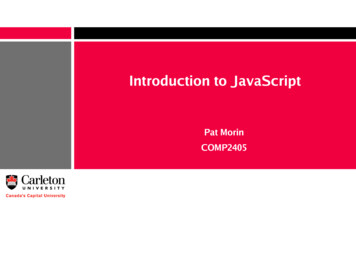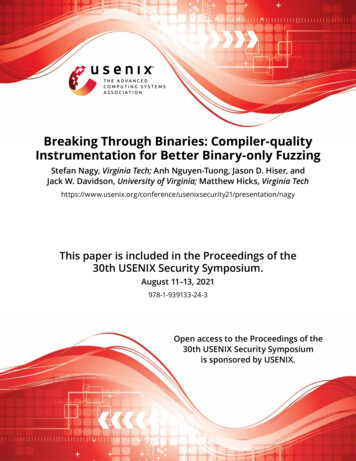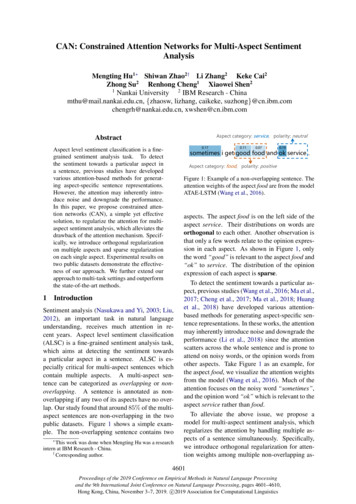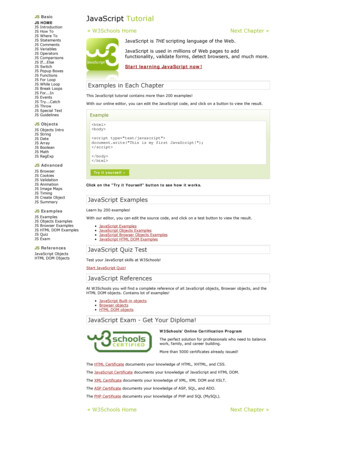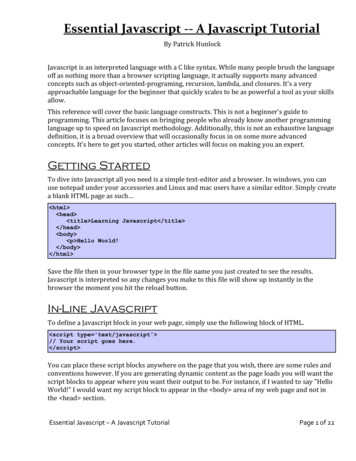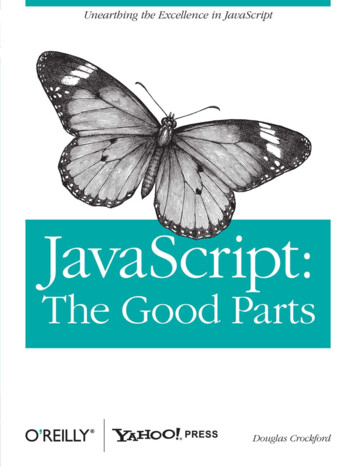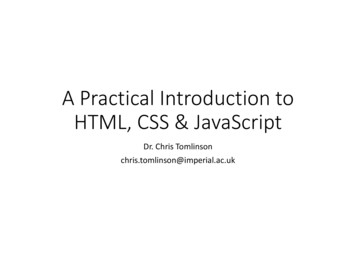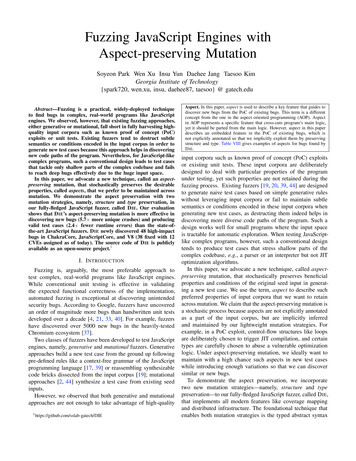
Transcription
Fuzzing JavaScript Engines withAspect-preserving MutationSoyeon Park Wen Xu Insu Yun Daehee Jang Taesoo KimGeorgia Institute of Technology{spark720, wen.xu, insu, daehee87, taesoo} @ gatech.eduAbstract—Fuzzing is a practical, widely-deployed techniqueto find bugs in complex, real-world programs like JavaScriptengines. We observed, however, that existing fuzzing approaches,either generative or mutational, fall short in fully harvesting highquality input corpora such as known proof of concept (PoC)exploits or unit tests. Existing fuzzers tend to destruct subtlesemantics or conditions encoded in the input corpus in order togenerate new test cases because this approach helps in discoveringnew code paths of the program. Nevertheless, for JavaScript-likecomplex programs, such a conventional design leads to test casesthat tackle only shallow parts of the complex codebase and failsto reach deep bugs effectively due to the huge input space.In this paper, we advocate a new technique, called an aspectpreserving mutation, that stochastically preserves the desirableproperties, called aspects, that we prefer to be maintained acrossmutation. We demonstrate the aspect preservation with twomutation strategies, namely, structure and type preservation, inour fully-fledged JavaScript fuzzer, called D IE. Our evaluationshows that D IE’s aspect-preserving mutation is more effective indiscovering new bugs (5.7 more unique crashes) and producingvalid test cases (2.4 fewer runtime errors) than the state-ofthe-art JavaScript fuzzers. D IE newly discovered 48 high-impactbugs in ChakraCore, JavaScriptCore, and V8 (38 fixed with 12CVEs assigned as of today). The source code of D IE is publiclyavailable as an open-source project.1Aspect. In this paper, aspect is used to describe a key feature that guides todiscover new bugs from the PoC of existing bugs. This term is a differentconcept from the one in the aspect oriented programming (AOP). Aspectin AOP represents a specific feature that cross-cuts program’s main logic,yet it should be parted from the main logic. However, aspect in this paperdescribes an embedded feature in the PoC of existing bugs, which isnot explicitly annotated so that we implicitly exploit them by preservingstructure and type. Table VIII gives examples of aspects for bugs found byD IE.input corpora such as known proof of concept (PoC) exploitsor existing unit tests. These input corpora are deliberatelydesigned to deal with particular properties of the programunder testing, yet such properties are not retained during thefuzzing process. Existing fuzzers [19, 20, 39, 44] are designedto generate naive test cases based on simple generative ruleswithout leveraging input corpora or fail to maintain subtlesemantics or conditions encoded in these input corpora whengenerating new test cases, as destructing them indeed helps indiscovering more diverse code paths of the program. Such adesign works well for small programs where the input spaceis tractable for automatic exploration. When testing JavaScriptlike complex programs, however, such a conventional designtends to produce test cases that stress shallow parts of thecomplex codebase, e.g., a parser or an interpreter but not JITI. I NTRODUCTIONoptimization algorithms.In this paper, we advocate a new technique, called aspectFuzzing is, arguably, the most preferable approach totest complex, real-world programs like JavaScript engines. preserving mutation, that stochastically preserves beneficialWhile conventional unit testing is effective in validating properties and conditions of the original seed input in generatthe expected functional correctness of the implementation, ing a new test case. We use the term, aspect to describe suchautomated fuzzing is exceptional at discovering unintended preferred properties of input corpora that we want to retainsecurity bugs. According to Google, fuzzers have uncovered across mutation. We claim that the aspect-preserving mutation isan order of magnitude more bugs than handwritten unit tests a stochastic process because aspects are not explicitly annotateddeveloped over a decade [4, 21, 33, 40]. For example, fuzzers as a part of the input corpus, but are implicitly inferredhave discovered over 5000 new bugs in the heavily-tested and maintained by our lightweight mutation strategies. Forexample, in a PoC exploit, control-flow structures like loopsChromium ecosystem [37].Two classes of fuzzers have been developed to test JavaScript are deliberately chosen to trigger JIT compilation, and certainengines, namely, generative and mutational fuzzers. Generative types are carefully chosen to abuse a vulnerable optimizationapproaches build a new test case from the ground up following logic. Under aspect-preserving mutation, we ideally want topre-defined rules like a context-free grammar of the JavaScript maintain with a high chance such aspects in new test casesprogramming language [17, 39] or reassembling synthesizable while introducing enough variations so that we can discovercode bricks dissected from the input corpus [19]; mutational similar or new bugs.To demonstrate the aspect preservation, we incorporateapproaches [2, 44] synthesize a test case from existing seedtwo new mutation strategies—namely, structure and typeinputs.However, we observed that both generative and mutational preservation—to our fully-fledged JavaScript fuzzer, called D IE,approaches are not enough to take advantage of high-quality that implements all modern features like coverage mappingand distributed infrastructure. The foundational technique that1 https://github.com/sslab-gatech/DIEenables both mutation strategies is the typed abstract syntax
tree, or typed-AST, which provides a structural view of an inputcorpus with the annotated type information of each node. Wedevelop a lightweight type analysis that statically propagatesthe observed type information extracted from dynamic analysis(§IV-A). Each mutation strategy embodies its own aspectpersevering elements by utilizing the shared typed-AST, e.g.,structure-preserving mutation respects structural aspects likeloops or breaches, and type-preserving mutation maintainstypes of each syntactic elements across mutation.We evaluate D IE with three popular JavaScript engines:ChakraCore in Microsoft Edge, JavaScriptCore in Apple Safari,and V8 in Google Chrome. Our evaluation shows that D IE’saspect-preserving mutation is more effective in discovering newbugs (5.7 more unique crashes) and producing high-qualitytest cases (2.4 fewer runtime errors) than the state-of-the-artJavaScript fuzzers (see §VI). D IE has newly discovered 48high-impact security bugs in ChakraCore, JavaScriptCore, andV8;38 of the bugs have been fixed with 12 CVEs assigned asof today ( 27K as bug bounty prize).In summary, this paper makes three contributions: We advocate a new aspect-preserving mutation approachthat aims to preserve desirable properties and preconditions of a seed input across mutation. We develop a fully-fledged JavaScript fuzzer, D IE , thatimplements two new mutation strategies—namely, structure and type preservation—by using a lightweight staticand dynamic type analysis. We have reported 48 new bugs and 38 are fixed duringthe responsible disclosure process: 28 in ChakraCore, 16in JavascriptCore, and four in V8.D IE will be open-sourced upon publication.JS FuzzerYearITjsfunfuzz [39]2007G2012 MLangFuzz [20]Skyfire [43]2017 M2018GFuzzilli [17]CodeAlchemist [19]2019 GSuperion [44]2019 M2019 MNautilus [2]D IE2019 G/MI: Input corpus, T: Type (G: generative, M:S: Semantic-aware, D: DistributedCSDCVEOS mutational), C: Coverage feedback,fuzzing, OS: Open source TABLE I: Classification of existing JavaScript engine fuzzers.for optimization. The engine then translates the first-levelIR (i.e., bytecode) into a sequence of lower-level IR (e.g.,B3 IR in JavaScriptCore) and ultimately to native machineinstructions for faster execution. Modern JavaScript enginesapply advanced optimization techniques, such as functioninlining and redundancy elimination (see Figure 4), duringthe compilation process. As part of the machine code, theJIT compiler inserts various checks (e.g., types) to validateassumptions made during the optimization, and falls back tothe unoptimized code if the optimized code failed at validation,called bailing out. Although user-facing interfaces like theparser and the interpreter are the straight implementation ofthe ECMA262 standard, JIT implementation is specific to eachJavaScript engine, e.g., low-level IRs, optimization techniques,etc. In other words, it is a desirable place for security auditing,thanks to the diversity of implementation and the complexityof the optimization logic.B. Fuzzing JavaScript EnginesThere are two popular types of JavaScript engine fuzzer,namely, generative and mutational (Table I). Generative fuzzersbuild new test cases from scratch based on pre-defined grammarlike jsfunfuzz [39] and Fuzzilli [17] or by constructing themfrom synthesizable code bricks disassembled from a largecorpus [19]. Mutational fuzzers generate new test cases on theA. JavaScript Enginesseed inputs for testing. For example, LangFuzz [20] breaksJavaScript engines are one of the complex components of programs in a large corpus into small code fragments, remodern browsers. Although the design and implementation combines them with a seed input, and generates new testof each JavaScript engine are very different, all share two cases; Skyfire [43], Nautilus [2] and Superion [44] mutatecommon properties: 1) serving as a standardized runtime for each program individually with the segments learned fromJavaScript and 2) providing JIT compilation for performance. other programs in the corpus or with their mutation rule.JavaScript. This is a dynamically typed language, meaning Modern fuzzers [2, 17, 19, 43, 44] all leverage code coverage tothat a variable can have an arbitrary type at any point during accelerate their exploration. However, most advanced generativeexecution. Also, the program can terminate with a syntactic or or mutational fuzzers fail to effectively explore a JavaScriptsemantic error at runtime (e.g., invalid references, unexpected engine for deep bugs on the trend (see §II-A) for two reasons:types in use). The JavaScript engines process it in multiple 1) Enormous search space. One major advantage of generphases: a parser first creates an AST, and an interpreter ative fuzzers is that they fully control the generation processconverts the AST into a first-level intermediate representation of every statement in a testing program. Therefore, building(IR) and then executes it with the help of the JavaScript runtime. error-free inputs is straightforward. However, generative fuzzersNote that the parser and interpreter of JavaScript engines have build completely new programs by starting from code units.rather simple logics, so no security bugs have been recently Meanwhile, a JIT-related bug requires a complicated input withreported in either component [13, 14].specific properties to trigger (see §II-A). Hence, the searchJIT compilation. At runtime, the engine profiles execution space is too large for a generative fuzzer to build such test(e.g., types, # of invocations) to find potential hot spots cases in a reasonable time.II. BACKGROUNDIn this section, we summarize the common design ofJavaScript engines, classify existing fuzzing approaches againstthem, and analyze a trend of recent JavaScript-related bugs.
125# of Bugs20JIT-OOBJIT-Type confusionJIT-Memory corruptionParser/Interpreterarr[0] 1.1;3typeof(arr[obj]);410arr[0] 1.1; (order)obj.x;arr[0] 2.3023e-320;arr[0] 2.3023e-320;}5}6function main() {function main() {7let arr [1.1, 2.2, 3.3];let arr [1.1, 2.2, 3.3];8for (let i 0; i 0x10000; i ){for (let i 0; i 0x10000; i ){915function opt(arr, obj) {function opt(arr, obj) {2opt(arr, {}); (precondition)10}11opt(arr, {toString: () {12arr[0] {};13throw 1;14let get Map.prototype.get;Map.prototype.get function (key) {Map.prototype.get get; }});arr[0] {};(type)1516return this.get(key);}175opt(arr, Intl);1802016201720182019YearFig. 1: The trend of the security bugs in ChakraCore from 2016to 2019. In each column, the right bar shows the number of bugsin ChakraCore’s parser, interpreter and its JavaScript runtime. Theleft bar indicates the number of bugs residing in the JIT compilationphases. We further classify the JIT compiler bugs by their types andout-of-bounds (OOB) access and type confusion caused by incorrectJIT behavior dominate.2) Insufficient utilization of existing programs. RecentJavaScript fuzzers select unit test suites and PoCs of knownbugs as their seed inputs. Basically, such a JavaScript programis carefully designed to have certain properties that particularlystress one or more working phases in a JavaScript engine.Therefore, starting with these inputs enables a fuzzer toquickly approach and explore the deep portion of the engine.Unfortunately, existing fuzzers fail to fully leverage thisprominent benefit from such programs. For example, the PoCof a JIT-related bug has its unique control flow and datadependencies among used variables, which explore the specificcode paths of an optimizer. However, once the PoC is brokeninto small normalized segments and mixed with the segmentsof other programs in a large corpus, the generative fuzzers likeCodeAlchemist [19] rarely hit the code paths in a reasonableamount of time. Also, semantic aspects are not respectedwhen the PoC is mutated by grammar-rule-based mutationalfuzzers like Superion [44] and Nautilus [2]. Different from theaforementioned fuzzers, D IE creates new JavaScript programsin a hybrid manner, synthesizing a seed corpus with a unitgenerated by generative methods. More importantly, D IE fullyrespects the properties of unit-test programs and PoCs. Inparticular, D IE mutates an individual program by replacing thecode segments that are unrelated to the properties with newones or simply inserting new statements. Meanwhile, the newsegments used for mutation are generated from scratch basedon the context.C. Trend of Recent VulnerabilitiesWe summarize the vulnerabilities (i.e., exploitable bugs withCVEs assigned) found in ChakraCore from 2016 to 2019 inFigure 1, which demonstrates the trend of vulnerabilities inJavaScript engines. We collect the vulnerability informationopt(arr, {});}print(arr[0]);19}20main();print(arr[0]); (new code)}main();(a) CVE-2018-0840(e.g., input corpus)(b) CVE-2018-8288(e.g., output test case)Fig. 2: Two PoC exploits for CVE-2018-0840 and CVE-2018-8288 ofChakraCore. Given a PoC-(a) as a seed input, PoC-(b) can only bediscovered when three conditions are met ( 1 – 3 ) but with enoughvariation introduced ( 4 ). Note that human hackers are particularlygood at exploring similar types of bugs in this manner—both PoCexploits are written by the same author [25, 26].from Google Project Zero issue trackers [14] and the commitsof ChakraCore for security updates [29]. All the vulnerabilitiesreside in either the parser and interpreter or the JIT compilerat the backend. The number of parser and interpreter bugshas been rapidly decreasing in the period. Meanwhile, the JITcompiler bugs gradually dominate. The JIT compiler bugs aremainly caused by incorrect speculation or wrong optimizationbased on logic error. We further divide these bugs by their typesand notice that most of the bugs result in out-of-bounds (OOB)access or type confusion. An ordinary program written inJavaScript, a typical high-level language, needs sophisticatedlycrafted code to trigger these cases. The goal of D IE is toeffectively generate such programs that are more likely to hitthese deep phases for finding JavaScript bugs in 2019.III. OVERVIEWA. MotivationHuman hackers have a particular interest in auditing similartypes of vulnerabilities. This intuitively makes sense, as thedevelopers likely introduced similar mistakes dispersedly tothe codebase. For example, Figure 2-(a) shows a bug in JITrelated optimizations [25]: a bailout condition is incorrectlyassumed and checked in the JIT-ed code. Figure 2-(b) showsa similar bug but with subtle differences: it is incorrectlyassumed to have no side effect in an exception (throw intoString) if suppressed by typeof in (a), but in (b), a sideeffect can be unexpectedly introduced by Map used duringthe initialization of Intl (for internationalization support).Accordingly, both exploits share many common preconditions,as shown in Figure 2. For example, 1 is required to satisfythe JIT-able condition by repeatedly invoking opt(), and 3 isrequired to trick the optimizer to incorrectly assume the typeof arr in opt() but to allow an optimization condition (i.e., aredundant check elimination) to be met.
Such an intuitive approach is not well respected when a PoC orders in a JIT-ed region are necessary to trigger an optimizationexploit is used as a seed input by automatic techniques like phase (e.g., a redundant check elimination, 3 in Figure 2).fuzzing. One possible explanation is that the goal of fuzzing by In contrast, widely-deployed blind mutation and generationdesign promotes exploration of new input spaces, which tends strategies tend to destroy these structures, e.g., at an extremeto encourage the fuzzer’s mutation strategies to destruct the end, the state-of-the-art JavaScript fuzzer, CodeAlchemist [19],conditions encoded in the seeding input. This decision is well dissects all seeding inputs and regenerates new test cases formade to increase the code coverage in fuzzing small programs. fuzzing. According to our evaluation, structure-preserving is theNonetheless, the input space for JavaScript-like complex most effective mutation technique to preserve various aspectsprograms having nearly a million lines of source code is (e.g., each JIT optimization phases §VI-D) of input corporainfeasible to be exhaustively explored. Also, recent trend of across mutation, which renders 2 more crashes than withoutbugs in JavaScript engines is not simple memory corruption the technique (Table VII).bugs that can be achieved by naive coverage-based testing, Type-preserving mutation. We also observe that respectingbut rather logic errors that need sophisticated conditions to types in an input corpus provides enough room for fuzzers toreach them. In other words, mutation strategies should focus on generate high-quality test cases while retaining aspects. Forproducing high-quality test cases instead of merely increasing example, an object type ( 2 in Figure 2) should match withcode coverage, so that it can reach meaningful, difficult-to-find the assumed argument type of the JIT-ed code ({} of opt() inbugs. For example, in Figure 2, an ideal strategy for fuzzers Line 9), otherwise the code should be bailed out in the JITis to preserve certain preconditions: keeping the conditions to execution. In other words, if the types of a seed input are notenable JIT in 1 , a type in 2 and an access order in 3 , preserved, the derived test cases end up stressing only a shallowwhile introducing a new code snippet ( 4 ) that can vary the part of the JavaScript engines (e.g., parser or interpreter). Ininternal mechanics of JavaScript’s optimization algorithms. If addition, preserving types significantly helps in producingFigure 2-(a) is used as an input corpus, existing coverage-based error-free test cases—both syntactic compilation errors andfuzzers likely discard conditions 1 – 3 because they are not dynamic runtime errors such as ReferenceError, TypeError,essential in discovering new code paths but are considered and RangeError. Note that such error conditions also preventredundant to the existing corpus.test cases from reaching the deep, complex logics of theJavaScript engines, and so they are considered a necessaryB. Challenges and Approachesprecondition to preserve various types of aspects of the originalAn ideal fuzzer would want to fully harvest the subtle condi- seed corpus. In this paper, we leverage a lightweight, typetions encoded in a high-quality input corpus such as known PoC analysis that statically propagates the observed type informationexploits [18] or JavaScript unit tests. Thus, the generated test from dynamic analysis (§IV-A). According to our evaluation,cases naturally satisfy the necessary preconditions to trigger a the type-preserving mutation reduces runtime errors 2 morenew bug. One possible approach would be to manually encode than the state-of-the-art fuzzer (Figure 5). Note that our typesuch conditions in each input corpus. However, this does not based mutation also aims to be semantic-aware, meaning thatwork for two reasons: 1) the number of input corpora is huge it attempts to avoid the destruction of aspects by respecting(14K, see §VI-A), and 2) more critically, it does not provide some semantics of a seed input, e.g., avoiding try-catch logicfuzzers enough freedom for space exploration, negating the that thwarts a JIT invocation.benefits of the fuzzing-like automated approaches. AnotherIV. D ESIGNapproach is to automatically infer such preconditions from eachcorpus via program analysis (e.g., data-flow analysis). However,D IE is a mutation-oriented JavaScript fuzzing frameworkthis also negates the true enabler of fuzzers, the performance, that respects the high-level aspects of seed inputs, such asi.e., reducing 10% input spaces for exploration after spending PoC exploits and unit tests, to generate effective test cases. To10% more computing power for additional analysis brings no achieve this, D IE mutates the AST of a JavaScript input bybenefit to the fuzzer.preserving with a high probability the code structure that affectsOur key approach is to stochastically preserve aspects, the the overall control flows and the original types of the useddesirable properties we prefer to be maintained across mutation. variables. Code coverage guidance and a distributed settingIt is a stochastic process because aspects are not explicitly also enable D IE to reach deep bugs in JavaScript engines withannotated as part of the corpus, but they are implicitly inferred scale.and maintained by our lightweight mutation strategies, so-called Workflow. Figure 3 illustrates D IE’s overall design andaspect-preserving mutation.workflow. First, D IE pre-processes original seed files to produceIn this paper, we realize aspect preservation with two their typed ASTs. Combining dynamic and static type analysis,mutation strategies, namely, structure and type preservation:D IE infers the node types in an AST with low overhead in 1 .Structure-preserving mutation. We observe that maintaining After type analysis, D IE picks a typed AST of a seed input fromcertain structures (e.g., control flow) of an input corpus tends the corpus for mutation ( 2 in Figure 3). Given the typed AST,to retain their aspects in the generated test cases. For example, D IE generates a new test case by replacing each node (whilea loop structure in a PoC exploit plays a significant role in preserving its type), or inserting a new node (while preservinginvoking JIT compilation ( 1 in Figure 2), and certain access the overall structure) ( 3 in Figure 3). By using the typed AST,
Pre-ProcessingExecution/FeedbackSeed GenerationMutated Typed-AST DynamicAnalysisInstrumentOriginal SeedsIMMUTABLETyped-NodeBuilderwhileཛ Type analysiswhileNUM ARRAY []aMutationEngine 1[].aInstrumentedJS EnginesNUM[]Static AnalysisAST NUMNUMaNUM ARRAY0ཞ ExecuteNUMaཝNUM ARRAY“length”Type Information0ཛྷ PickMutate(Aspect-preserving)DistributedFuzzing PlatformIMMUTABLEwhileTyped-ASTNUMCorpus []1a0NUM ARRAYNUMInputཟ FeedbackMutatedSeedsNUMCoverage FeedbackCrash ReportFig. 3: Design overview of D IE. First, D IE pre-processes (e.g.,instrument) all the original seed files to construct a typed AST via dynamic/staticanalysis ( 1 ). In the main fuzzing loop, D IE selects a test case from the corpus along with its typed AST ( 2 ). Next, D IE mutates the typedAST by modifying/inserting new nodes while maintaining its structure and type information ( 3 ). Note that the typed-node builder interactswith mutation engine supporting aspect-preserving mutation. Afterward, the AST is converted back to a JavaScript file and examined by thefuzzing platform ( 4 ). Finally, D IE measures the runtime coverage for feedback, which determines whether or not the new file will be saved.If the engine crashes at runtime, D IE records the input ( 5 ). D IE can be deployed in a distributed environment where a certain amount ofgenerated inputs are tested in parallel.D IE aims to preserve the type during the mutation process,so-called type-preserving mutation, and aims to preserve thecontrol-flow structure, so-called structure-preserving mutation,each of which tends to maintain certain aspects implicitlyembodied in the original corpus across mutation. After mutation,D IE executes the newly generated test case in 4 and checksif the execution crashes or terminates without an error. As thetarget JavaScript engine is instrumented, D IE can obtain theruntime coverage after executing the test case, and store it asa new input corpus in 5 if it visits any new code path. D IEalso supports distributed fuzzing by using multiple machinesto find bugs concurrently.types is considered an Any array. (2) Object: D IE stores theshape of an Object instance, which is composed of the typesof its property keys and values. (3) Function: D IE considersthe argument and return type of a Function instance.D IE’s custom type system is an essential feature to bettersupport the mutation based on the semantic informationextracted from the given test cases. For instance, being awareof several Number members of an existing Object, D IE hasmore building blocks for creating a valid Number expressionthan an existing fuzzer. In addition, D IE introduces fewersemantic errors from its mutation. For example, with the refinedArray types, D IE prefers the element of a Number array to anarbitrary array for mutating an array index (e.g., from arr[i]A. Custom JavaScript Type Systemto arr[int arr[j]]).D IE refines the original type system of JavaScript. TheBased on the custom type system, D IE abstracts everyrefined type system has two unique properties that are tailored JavaScript operation, including expressions and APIs for builtfor fuzzing but are different from other JavaScript fuzzers [17, in objects into one or more type reduction rules. Each rule19, 39]:declares the type of the return value when the operationMixed type. D IE introduces a new type called Mixed for the is invoked with the arguments of particular types. Table IIsyntactic units in a JavaScript program, which captures types summarizes how D IE redefines the addition and array indexingthat vary at runtime. Note that since JavaScript is a weak- and operations. The default return type of an addition in JavaScriptdynamic- typed language, the type of each variable can only be is String unless both of the operands are Numbers. Moreover,determined at runtime and even can change during its lifetime. the return value of indexing an array totally depends on theMixed is introduced to describe all types that each syntactic type of element. Note that D IE relies on these rules to inferAST node types for typed AST construction (see §IV-B) andunit can potentially have.Detailed compound types. D IE inspects the sub-element build new AST nodes for a mutation (see §IV-C).type(s) of a JavaScript object to define compound types in amore fine-grained manner. (1) Array: D IE records the common B. Typed ASTstype of the elements in an array, which can be Number orBasically, D IE mutates the syntactic units (i.e., AST nodes)String. An array that has empty slots or elements of various of a saved JavaScript file in the corpus so as to generate new
OperationArg. typesRequire l-val.Ret. typeEnsure l-val.arg1 arg2Num., Num.Any, Anyfalse, falsefalse, falseNum.Str.falsefalseNum. Arr., Num.Str. Arr., Num.Arr., Num.false, falsefalse, falsefalse, arg2]arg1 TABLE II: The examples of typed operation rules described in D IE:addition and array indexing. The rules are used to statically infer thetype of every AST node of a seed input and also guide the generationof new typed AST nodes.then utilizes the context to construct a new AST whose valuetype is compatible with the expected one.Algorithm 1 Constructing a random typed AST that has adesired value type.1:2:3:4:5:6:inputs for testing. To build new AST nodes for mutation whilekeeping the validity of a generated input, D IE retrieves thetype and binding information of every seed file at the firststage. In particular, for each node of the AST retrieved from aseed file, D IE extends it with (1) its potential type(s) refined byD IE (see §IV-A) at runtime and (2) a set of declared variablesavailable within its scope. We name such an extended AST thatcontains the type and binding information for every AST nodeas a typed AST. D IE maintains the typed AST for every savedinput in the corpus and mutates the typed AST to generatenew JavaScript files.As JavaScript is a weak- and dynamic- typed language, D IEaims to infer all the possible types that an AST node may haveat runtime. D IE achieves this through heterogeneous approaches.First, D IE dynamically collects the type(s) of every AST nodethat represents an identifier, namely, a reference to a particularvariable, in a seed file. After parsing out the AST of a seed,D IE instruments the seed by adding a trampoline right beforethe statement that references an identifier node. The trampolinejumps to a type profiling function that retrieves the type of theidentifier at the moment. Note that the function traverses anArray and iterates all the members of an Object for a refinedtype enforced by D IE. D IE then runs the instrumented seedfile and deduplicates the record types of an identifier output atruntime for an eventual type set. With the determine
Soyeon Park Wen Xu Insu Yun Daehee Jang Taesoo Kim Georgia Institute of Technology {spark720, wen.xu, insu, daehee87, taesoo} @ gatech.edu Abstract—Fuzzing is a practical, widely-deployed technique to find bugs in complex, real-world programs like JavaScript engines. We observed, however, that existing fuzzing approaches,
